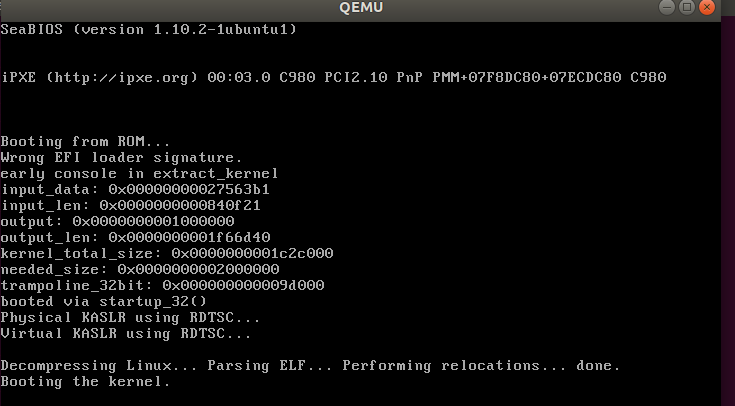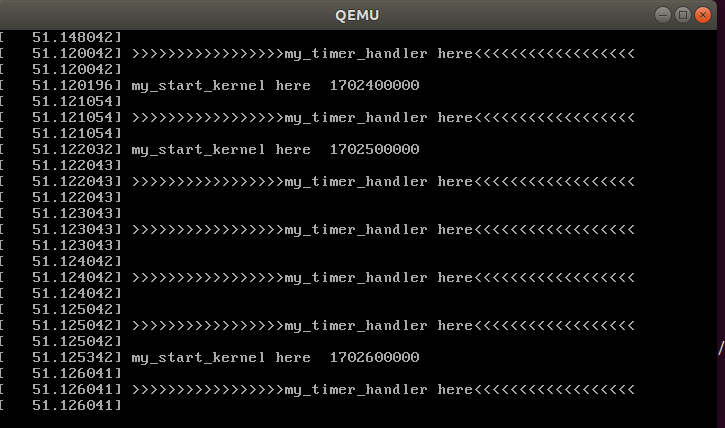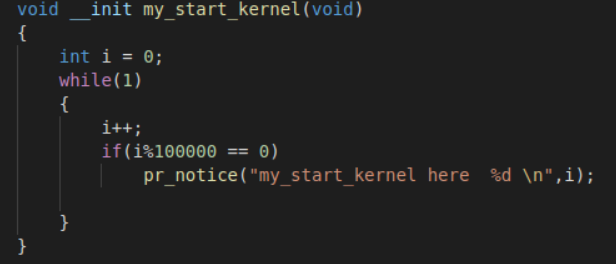实验题目 基于mykernel 2.0编写一个操作系统内核
一 按照https://github.com/mengning/mykernel 的说明配置mykernel 2.0,熟悉Linux内核的编译;
1.进入该网址按照给定的命令行配置环境

其中也遇到了一些问题,由于patch文件老师已经给了,所以没有使用wget命令下载,但是下载的位置是在根目录下,所以需要将文件复制到根目录下才不会报错。
加一行命令 sudo cp mykernel-2.0_for_linux-5.4.34.patch / #将文件复制到根目录下。
将上述命令执行之后可以看到my_start_kernel在qemu窗口执行,同时my_timer_handler时钟中断处理程序周期性执行如下图。


当前有一个CPU执行C代码的上下文环境,同时具有中断处理程序的上下文环境,通过Linux内核代码模拟了一个具有时钟中断和C代码执行环境的硬件平台。
从输出内容可以看出每100000次计数便输出一次my_start_kernel here,而my_timer_hander here就是周期性产生的时钟中断。如下为代码


2.基于mykernel 2.0编写一个操作系统内核,参照https://github.com/mengning/mykernel 提供的范例代码
接下来要在mymain.c基础上继续写进程描述PCB和进程链表管理等代码,在myinterrupt.c的基础上完成进程切换代码,一个可运行的小OS kernel就完成了
首先在mykernel目录下增加一个mypcb.h 头文件,用来定义进程控制块(Process Control Block),也就是进程结构体的定义,在Linux内核中是struct tast_struct结构体。
#define MAX_TASK_NUM 4 #define KERNEL_STACK_SIZE 1024*2 /* CPU-specific state of this task */ struct Thread { unsigned long ip; unsigned long sp; }; typedef struct PCB{ int pid; volatile long state; /* -1 unrunnable, 0 runnable, >0 stopped */ unsigned long stack[KERNEL_STACK_SIZE]; /* CPU-specific state of this task */ struct Thread thread; unsigned long task_entry; struct PCB *next; }tPCB; void my_schedule(void);
然后对mymain.c进行修改,这里是mykernel内核代码的入口,负责初始化内核的各个组成部分。在Linux内核源代码中,实际的内核入口是init/main.c中的start_kernel(void)函数。
#include <linux/types.h> #include <linux/string.h> #include <linux/ctype.h> #include <linux/tty.h> #include <linux/vmalloc.h> #include "mypcb.h" tPCB task[MAX_TASK_NUM]; tPCB * my_current_task = NULL; volatile int my_need_sched = 0; void my_process(void); void __init my_start_kernel(void) { int pid = 0; int i; /* Initialize process 0*/ task[pid].pid = pid; task[pid].state = 0;/* -1 unrunnable, 0 runnable, >0 stopped */ task[pid].task_entry = task[pid].thread.ip = (unsigned long)my_process; task[pid].thread.sp = (unsigned long)&task[pid].stack[KERNEL_STACK_SIZE-1]; task[pid].next = &task[pid]; /*fork more process */ for(i=1;i<MAX_TASK_NUM;i++) { memcpy(&task[i],&task[0],sizeof(tPCB)); task[i].pid = i; task[i].thread.sp = (unsigned long)(&task[i].stack[KERNEL_STACK_SIZE-1]); task[i].next = task[i-1].next; task[i-1].next = &task[i]; } /* start process 0 by task[0] */ pid = 0; my_current_task = &task[pid]; asm volatile( "movq %1,%%rsp " /* set task[pid].thread.sp to rsp */ "pushq %1 " /* push rbp */ "pushq %0 " /* push task[pid].thread.ip */ "ret " /* pop task[pid].thread.ip to rip */ : : "c" (task[pid].thread.ip),"d" (task[pid].thread.sp) /* input c or d mean %ecx/%edx*/ ); } int i = 0; void my_process(void) { while(1) { i++; if(i%10000000 == 0) { printk(KERN_NOTICE "this is process %d - ",my_current_task->pid); if(my_need_sched == 1) { my_need_sched = 0; my_schedule(); } printk(KERN_NOTICE "this is process %d + ",my_current_task->pid); } } }
在mymain.c中添加了my_process函数,用来作为进程的代码模拟一个个进程,
此外还需要时钟记录中断处理过程中的时间片,对myinterrupt.c中修改my_timer_handler用来记录时间片。
对myinterrupt.c进行修改,主要是增加了进程切换的代码my_schedule(void)函数。
#include <linux/types.h> #include <linux/string.h> #include <linux/ctype.h> #include <linux/tty.h> #include <linux/vmalloc.h> #include "mypcb.h" extern tPCB task[MAX_TASK_NUM]; extern tPCB * my_current_task; extern volatile int my_need_sched; volatile int time_count = 0; /* * Called by timer interrupt. * it runs in the name of current running process, * so it use kernel stack of current running process */ void my_timer_handler(void) { if(time_count%1000 == 0 && my_need_sched != 1) { printk(KERN_NOTICE ">>>my_timer_handler here<<< "); my_need_sched = 1; } time_count ++ ; return; } void my_schedule(void) { tPCB * next; tPCB * prev; if(my_current_task == NULL || my_current_task->next == NULL) { return; } printk(KERN_NOTICE ">>>my_schedule<<< "); /* schedule */ next = my_current_task->next; prev = my_current_task; if(next->state == 0)/* -1 unrunnable, 0 runnable, >0 stopped */ { my_current_task = next; printk(KERN_NOTICE ">>>switch %d to %d<<< ",prev->pid,next->pid); /* switch to next process */ asm volatile( "pushq %%rbp " /* save rbp of prev */ "movq %%rsp,%0 " /* save rsp of prev */ "movq %2,%%rsp " /* restore rsp of next */ "movq $1f,%1 " /* save rip of prev */ "pushq %3 " "ret " /* restore rip of next */ "1: " /* next process start here */ "popq %%rbp " : "=m" (prev->thread.sp),"=m" (prev->thread.ip) : "m" (next->thread.sp),"m" (next->thread.ip) ); } return; }
最后对修改好的内核按照上次重新编译运行结果如下

3.简要分析操作系统内核核心功能及运行工作机制
汇编代码分析:
进程0启动代码
movq %1,%%rsp :将RSP寄存器指向进程0的堆栈栈底,task[pid].thread.sp初始值即为进程0的堆栈栈底。
pushq %1 :将当前RBP寄存器的值压栈,因为是空栈,所以RSP与RBP相同。
pushq %0 :将当前进程的RIP(这里是初始化的值my_process(void)函数的位置)入栈,相应的RSP寄存器指向的位置也发生了变化,RSP = RSP - 8,RSP寄存器指向堆栈底部第二个64位的存储单元。
ret :将栈顶位置的task[0].thread.ip,也就是my_process(void)函数的地址放入RIP寄存器中,相应的RSP寄存器指向的位置也发生了变化,RSP = RSP + 8,RSP寄存器指向堆栈底部第一个64位的存储单元。
这样就完成 了进程0的启动。
进程切换关键汇编代码